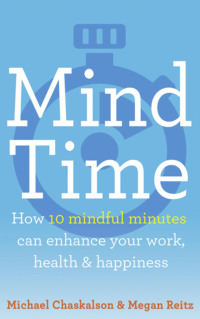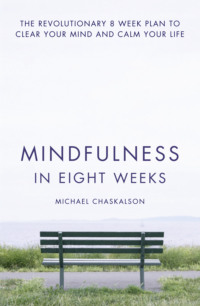
Полная версия
Mindfulness in Eight Weeks

It is because mindfulness works that it’s being found in so many different contexts these days. The variety of approaches and applications is extraordinary. NICE, the UK’s National Institute for Health and Clinical Excellence that advises the UK National Health Service on appropriate clinical provision, recommends it as a front-line treatment in instances of relapsing depression. The United States Marine Corps, on the other hand, has found that it helps soldiers remain mentally flexible, cognitively clear and emotionally appropriate under pressure. Some people use mindfulness to help them manage chronic pain and there is good research evidence for its efficacy there. Others come to it because they want to be more focused and effective at work, or because they want to be more resilient, or more empathic.
In whatever way or for whatever reason you come to mindfulness training, there is now a large body of evidence that shows that with just eight weeks of training really substantial changes are possible.
There is a considerable and growing body of research evidence around the effectiveness of mindfulness training these days. Peer-reviewed research papers are currently emerging at a rate of around 40 per month. I won’t try to sum up all of that evidence here, but the UK’s Mental Health Foundation commissioned a report which examined the health benefits of mindfulness training. Their 2010 Mindfulness Report noted that evidence coming from mindfulness and well-being research shows that mindfulness confers significant benefits on health, well-being and quality of life in general:
According to the report, people who are more mindful are less likely to experience psychological distress, including depression and anxiety. They are less neurotic, more extroverted and report greater well-being and life satisfaction.
They have greater awareness, understanding and acceptance of their emotions, and recover from bad moods more quickly.
They have less frequent negative thoughts and are more able to let them go when they arise.
They have higher, more stable self-esteem that is less dependent on external factors.
They enjoy more satisfying relationships, are better at communicating and are less troubled by relationship conflict, as well as less likely to think negatively of their partners as a result of conflict.
Mindfulness is correlated with emotional intelligence, which itself has been associated with good social skills, ability to cooperate and ability to see another person’s perspective.
People who are mindful are also less likely to react defensively or aggressively when they feel threatened. Mindfulness seems to increase self-awareness, and is associated with greater vitality.
Being more mindful is linked with higher success in reaching academic and personal goals.
Practising meditation has repeatedly been shown to improve people’s attention, as well as improve job performance, productivity and satisfaction, and to enable better relationships with colleagues, resulting in a reduction of work-related stress.
People who are mindful feel more in control of their behaviour and are more able to override or change internal thoughts and feelings and resist acting on impulse.
Meditation practices more generally have been shown to increase blood flow, reduce blood pressure and protect people at risk of developing hypertension; they have also been shown to reduce the risk of developing and dying from cardiovascular disease, and to reduce the severity of cardiovascular disease when it does arise.
People who meditate have fewer hospital admissions for heart disease, cancer and infectious diseases, and visit their doctor half as often as people who don’t meditate.
Mindfulness can reduce addictive behaviour, and meditation practices generally have been found to help reduce use of illegal drugs, prescribed medication, alcohol and caffeine.
Neuroscience Research
We also know that mindfulness training has a significant impact on how the brain is shaped, wired and activated. After just eight weeks of mindfulness training we know from separate studies that one might expect:
increased brain grey-matter concentration in areas connected with sustained attention, emotional regulation and perspective taking;
increased cortical thickness;
decreased amygdala activation: the amygdala is a key component in the brain’s threat-detection system – when it is less active you feel more at ease with yourself and others;
increased activity in the left prefrontal cortex and less activity in the right prefrontal cortex: the ratio of left to right prefrontal activation is a good predictor of overall happiness and well-being – if the left prefrontal is more active then you’re likely to experience higher levels of well-being;
increased working-memory capacity: working memory is the system that actively holds information in the mind to do tasks such as reasoning and comprehension, and to make it available for further information processing. Measures of working-memory capacity are strongly related to success in the performance of complex cognitive tasks. It is also a key component in emotion regulation and it is reduced by acute or chronic stress.
The skills that emerge from mindfulness training are gradually beginning to be recognised as crucial life skills. Really, we should all have learned them at school and it is deeply heartening that programmes for schoolchildren and young adults, like .b and the programme developed by my colleagues at Bangor University, are beginning to find their way into schools. Most of us missed that chance, but thankfully it is never too late to learn.
I sometimes begin my programmes by asking how many people in the room think that regular physical training can be crucial for their health and well-being. Everyone puts up their hand. I then ask how many people think that regular mental training can be crucial for their health and well-being. Most people put up their hand, a little more tentatively perhaps. I then point out that, had I asked the physical-training question to a general audience at the end of the nineteenth century, very few would have raised their hand. And, indeed, even as late as 1970, when the New York City marathon was first run with 127 entrants, of whom fewer than half completed the course, it was thought that only a few thousand people in the United States had the capacity to run a marathon. In 2010, 44,829 people finished – a world record for a marathon race – and every year tens of thousands of potential entrants are unsuccessful in the lottery for starting places.
There has been a paradigm shift in our cultural attitude to physical fitness.
We are now on the brink of another paradigm shift. We are beginning to recognise the importance of what we might think of as mental and emotional fitness and to see how we can train to build this.
When you’re more skilled at working with your mind and mental states, things go better: for you and everyone around you.
Before Beginning the Course
You will read about a number of different mindfulness practices in each chapter of this book. If you’re using the book as a do-it-yourself manual for the eight-week course, it would be best to do the practices in the order in which they are described.
To that end, it would be good, if you can, to read the book at a time when and in a place where you’re less likely to be disturbed. It would also be good to be able to engage in some of the meditations in the order in which they are taught. Some of the time, where indicated, you might want to put the book aside and take the time to listen to the particular audio material for that part of the course. The track name and its timing are shown at the appropriate place in the text.
Since you’ll be doing different meditations from time to time, it will generally be good to have access to an upright chair, rather like a kitchen or dining chair, or a meditation bench or cushion if you want to meditate sitting on the floor. I’ll say more about the postures for sitting meditation when we come to that part of the course.
For Week One, beginning in the following chapter, there are two other items of equipment you’ll need.
There is the option for doing one of our meditations lying on the floor, so you might want to have a rug or mat handy for that.
And our first meditation is going to be an eating meditation. But we’re not going to eat very much – just one raisin in fact – and I’ll be providing fairly detailed guidance on how to do that as an eating meditation. So if you’re going to read on, now might be a good time to go and find yourself a raisin. If you don’t have one handy, a very small section of any fruit or vegetable that you can eat will do instead.
Конец ознакомительного фрагмента.
Текст предоставлен ООО «ЛитРес».
Прочитайте эту книгу целиком, купив полную легальную версию на ЛитРес.
Безопасно оплатить книгу можно банковской картой Visa, MasterCard, Maestro, со счета мобильного телефона, с платежного терминала, в салоне МТС или Связной, через PayPal, WebMoney, Яндекс.Деньги, QIWI Кошелек, бонусными картами или другим удобным Вам способом.






